|
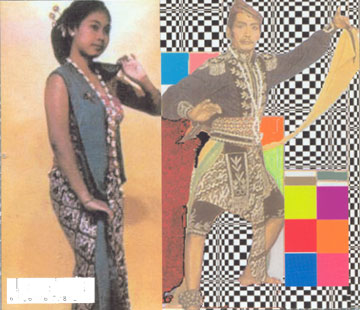
Chances
are that Blastitude regulars will already know about the SUBLIME
FREQUENCIES imprint. For those who have yet to hear,
it is a CD and DVD label spearheaded by Alan Bishop of the
Sun City Girls with help from some of the usual unusual suspects.
This new endeavor was referred to, ever-obliquely, in last
issue's conversation with Dylan Nyoukis: "I keep
having wheezing flatliner bozos muttering in my ear about
the 100's of hours of film that SCG have made, what gives?"
"We're gonna be flippin' DVDs like frisbees right quick
now and I'll be damned if every hackysack fuckstick won't
be inside watchin', it's better than a noose around the neck."
"Hell, I just hope you stay true to betamax, Brother
Ape."
I think
we all assumed he meant they'd be frisbee-flippin' DVDs of
the Sun City Girls performing, such as perhaps a reissue of
the absolutely essential Cloaven Theatre VHS release, but
no, Sublime Frequencies is an outlet for the massive amounts
of audio and video the Bishops and crew have accumulated not
as performers, but as world travelling ethnomusicologists.
That word may make ya smart a little, Elizabeth, but we're
all ethnomusicologists, so let 'er rip. Especially when this
is your mission statement: "SUBLIME FREQUENCIES is a
collective of explorers dedicated to acquiring and exposing
obscure sights and sounds from modern and traditional urban
and rural frontiers via film and video, field recordings,
radio and short wave transmissions, international folk and
pop music, sound anomalies, and other forms of human and natural
expression not documented sufficiently through all channels
of academic research, the modern recording industry, media,
or corporate foundations."
Pretty
much says it all, right? And in fact, one of the best things
about this label is the way that it removes explanation and
agenda and authority so that the music and culture can stand
alone. Each release comes with a few introductory paragraphs
and bare-bones song/artist/style track listings, but that's
about it, because Bishop and co. know that you can explain
things until you're blue in the face but you'll still never
see the whole picture, and who needs to, when the human imagination
has so much fun filling in the rest . . . . and with that
I turn it over to Brother Bishop: "There are so many
different cultures spread-out on these islands, that it would
take several lifetimes to experience them all properly."
. . . . . "Music thought NOT to exist is EVERYWHERE!"
. . . . "As you know, we are not experts at this....there
ARE no experts at anything. This music and sound/cultural
phenomenon is NOT science and it cannot be captured or owned.
It is interactive and its traditions are NOT sacred or defineable.
These people ARE us. There is no separation other than the
cancer of misunderstanding and categorization so malevolently
put in place by the ruling elite in order to control thought
and behavior." (most
Alan Bishop quotes on this page come from this
feature on the excellent Pataphysics
Research Lab website)
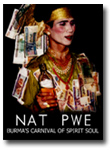
To which
I can only add three words (one in all-caps): "Right
Motherfucking ON." And to hear and see some prime "sound/cultural
phenomenon" that "cannot be captured or owned"
and that is "NOT sacred or defineable," go no further
than the Nat Pwe: Burma's Carnival of Spirit Soul
DVD. One of its opening shots seems to encapsulate
this thesis, a closeup of a mirror slowly spinning in a crowded
marketplace, reflecting ever-changing blurred visions. I think
it's the definitive release of the label. (It's also the one
I checked out first, so that might have something to do with
it.)
As for
the back story, Burmese tradition recognizes a pantheon of
37 Nats, mythical figures that are a combination of ghost
and deity. A Pwe is "a ceremony held to appease a Nat."
The Nat Pwe festival documented on this DVD happens once a
year in the Burmese village of Taungbyone, and the scope of
the activity is almost impossible to do justice in a review
like this one, although here is one sentence from the liner
essay: "There are dozens of venues with ceremony, music,
and dance happening simultaneously for an exhausting two days
without interruption, all taking place in a maze of bamboo
shelters constructed as a small, narrow-alley village for
the purpose of this six day gathering."
Just
to give you a taste, I'll add that the "ceremony, music,
and dance" involve things like makeshift golden byzantine
altars, marathon-dancing cross-dressers and transvestites
gulping whiskey, money literally being thrown around, women
singing / toasting / emceeing through booming portable sound-systems,
and people of all shapes, sizes, genders, and ages getting
WILD. All of this was also alluded to in last issue's conversation,
thusly: "72 hours non-stop multiplied by the 60 simultaneous
venues, thats what? 4500 hours of the greatest show on earth?
Who's gonna read this?" "A handful of pot smoking
grongos." "I should shut up. I only saw 3 white
people there last year!" I had no idea what they were
talking about then (except for the part about "pot smoking
grongos") but now here's the DVD to give anyone a view.
It should be noted that Rick Bishop is the sole camera operator
credited, and he does a stunning job of becoming that pair
of eyes you wish you had on every road trip you've ever taken.
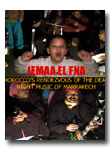 The
other DVD released by Sublime Frequencies so far is called Jemaa
El Fna, Morocco's Rendezvous of the Dead: Night Music of Marrakech,
and it's a more low-key affair. The Nat Pwe is a daytime riot
of color sound and motion, while the Jemaa El Fna is a late-night
town-square jam session, in the remote mountain pass city
of Marrakesh. The crowd is smaller and the spectacle is muted,
and initially the audio portion is more exciting than the
visual, but the images sneak up on you and become unforgettable.
For example, I didn't know that they wore and played fiddles
like guitars in Marrakesh, but now I do. There's also a totally
fucked-up sequence in which a DJ plays records that literally
look and sound like they were made in the 1700's (B.C., that
is). There's also a great jam session in which a dapper blind
man sits in a chair and jams on fiddle (he kinda looks like
Uncle Jim!) while a stylish 20-something in a designer sweater
and necklace (he looks like he could be talking on a cell
phone in Brooklyn) jams on hand drum while a very expressive
young girl (could this be three generations from one family?)
steals the show as emcee, lead vocalist, and dancer. The
other DVD released by Sublime Frequencies so far is called Jemaa
El Fna, Morocco's Rendezvous of the Dead: Night Music of Marrakech,
and it's a more low-key affair. The Nat Pwe is a daytime riot
of color sound and motion, while the Jemaa El Fna is a late-night
town-square jam session, in the remote mountain pass city
of Marrakesh. The crowd is smaller and the spectacle is muted,
and initially the audio portion is more exciting than the
visual, but the images sneak up on you and become unforgettable.
For example, I didn't know that they wore and played fiddles
like guitars in Marrakesh, but now I do. There's also a totally
fucked-up sequence in which a DJ plays records that literally
look and sound like they were made in the 1700's (B.C., that
is). There's also a great jam session in which a dapper blind
man sits in a chair and jams on fiddle (he kinda looks like
Uncle Jim!) while a stylish 20-something in a designer sweater
and necklace (he looks like he could be talking on a cell
phone in Brooklyn) jams on hand drum while a very expressive
young girl (could this be three generations from one family?)
steals the show as emcee, lead vocalist, and dancer.
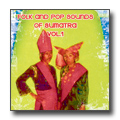
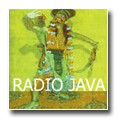
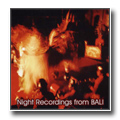 And
then there's the CDs. Yep, a lot of product, and Sublime Frequencies
has no intention of slowing down, with talk of "20 or
more titles after a year or so." Three discs so far,
and they are all simply very, very good. My favorite is probably
Folk and Pop Sounds of Sumatra Vol. 1 (SF001),
which was assembled "from old cassette tapes received
as gifts, in trade, or purchased from sources in Sumatra in
1989." Again there isn't a whole lot of information given,
although you can learn that the island of Sumatra is roughly
the size of California, and that it contains at least as much
musical variety, which is suggested by the track listing's
inclusion of "music style" for each number . . .
any of y'all familiar with the Haroan Boru, Sumatran Dangdut,
Tapanuli, Orkes Melayu Asli, and Saluang Dangdut styles? And
really, when a song is as beautiful as "Indang Pariaman"
by Samsimar, does it even matter? Seriously, you've gotta
hear this one, 1980s pop rock production supporting the classic
Southeast Asian female pop rock vocal style as she duels with
a tranced-out wood flute part -- or is it a keyboard setting?
Some say the SCG have done a cover version of this song. I
don't think I've heard it, but I do know their song "Borungku
Si Derita," from the double 7-inch of the same title
(Majora, 1993), and this disc contains the rather glorious
original version, as performed by the Marios Group. And
then there's the CDs. Yep, a lot of product, and Sublime Frequencies
has no intention of slowing down, with talk of "20 or
more titles after a year or so." Three discs so far,
and they are all simply very, very good. My favorite is probably
Folk and Pop Sounds of Sumatra Vol. 1 (SF001),
which was assembled "from old cassette tapes received
as gifts, in trade, or purchased from sources in Sumatra in
1989." Again there isn't a whole lot of information given,
although you can learn that the island of Sumatra is roughly
the size of California, and that it contains at least as much
musical variety, which is suggested by the track listing's
inclusion of "music style" for each number . . .
any of y'all familiar with the Haroan Boru, Sumatran Dangdut,
Tapanuli, Orkes Melayu Asli, and Saluang Dangdut styles? And
really, when a song is as beautiful as "Indang Pariaman"
by Samsimar, does it even matter? Seriously, you've gotta
hear this one, 1980s pop rock production supporting the classic
Southeast Asian female pop rock vocal style as she duels with
a tranced-out wood flute part -- or is it a keyboard setting?
Some say the SCG have done a cover version of this song. I
don't think I've heard it, but I do know their song "Borungku
Si Derita," from the double 7-inch of the same title
(Majora, 1993), and this disc contains the rather glorious
original version, as performed by the Marios Group.
Which
brings me to my next point: not only is everything thus far
in the Sublime Frequencies catalog as good as any of the classics
I've heard from labels like Nonesuch, but they also have special
interest for the Sun City Girls aficionado. Here I've spent
all these years speculating about the SCG's music -- is it
traditional? is it appropriation? is it a cover? an homage?
is it in Esperanto? -- and now it's almost like they've handed
me the goddamn fakebook. For example, on Night
Recordings from BALI (SF003), there are sections
where dervishes speak in tongues over gamelan chime that could
come right off of Flute and Mask, as well as sounding
like the roots of certain aspects of the SCG's Cloaven Theatre
style. Explicit Cloaven roots are also revealed by the "Drama"
style, as represented by a few unsettling examples on both
the Sumatra disc and the Radio Java disc.
Radio
Java (SF002), "a combination of random
radio excerpts sequenced in collage form and assembled in
the summer of 1989," is as dazzling and colorful and
all over the place as the Sumatra disc, maybe more
so. A lot of similar styles are on display ("from Dangdut
and Keroncong to Hard Rock and Disco") but Java adds
disc jockeys and commercials and general high-energy radio
madness to the mix. The BALI disc is to these two
as the Jemaa El Fna DVD is to the Nat Pwe
DVD -- a more chilled-out and late-night affair, although
not being able to see who's making the sounds makes it a little
spookier too.

Then there's
the self-titled Neung Phak (Mono
Pause) CD. It's not on Sublime Frequencies, it's on Abduction,
the longer-running in-house SCG label. It's still appropriate
to include it here, because if the Sublime Frequencies lineup
could be considered the syllabus for a fascinating course
on musics of Southeast Asia, then Neung Phak would
be the final class project. It would easily get an A, but
my first impression was that, out of all these wallet-bombingly
essential releases, it was the last one to get. Listening
to their flawless renditions of Southeast Asian pop music
(the credits say "All Music Written By NEUNG PHAK (Except
2-11 and 15)," and that's out of 15 tracks), I just couldn't
help but want to use words like "appropriation"
and "kitsch" -- and it's not the appropriation that
bothers me, it's the kitsch, that big-city art-school knowingness
that makes the style like a knick-knack or a gewgaw rather
than something deeply felt. The Sun City Girls, perhaps because
they stayed in the desert for so long, have always managed
to avoid being kitschy. Even on Midnight Cowboys at Ipanema
they avoid being kitschy. Even while being kitschy
they avoid being kitschy.
But the
more I listen to Neung Phak, the more I have to admit that
these people are just plain REALLY GOOD. They sound like the
best session players from the top film orchestra in [fill
in any one of the 5-7 appropriate Pan-Asian nations here].
They're sort of like the Sun City Girls Orchestra or the Sun
City Girls Big Band, and Alan Bishop does sing on this album,
contributing some of his most delectable torch-singing yet
to the song "Low Tide." (Don't let that "Aye
Chan Nyein" credit fool you, and I'd keep a close eye
on this "Hitman Kong Thep" character that appears
on track fourteen, "Morlam Pee Bah," and makes it
such a 12-minute tour de force in the aforementioned 'theater'
style.) Really, these folks have put an untold amount of time
and study in this -- their track listing actually uses the
Asian alphabet. You can appropriate all you want if you do
it this well.
www.sublimefrequencies.com
suncitygirls.com
And
now, a bonus Sun City Girls review!
SUN
CITY GIRLS: Bleach Has Feelings Too/To Cover Up Your Right
To Live 2LP (ECLIPSE)
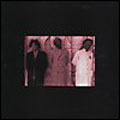 Well,
already with the 2nd installment, the SCG are saying "Whoah,
fans and friends, let's not take this 'all the cassettes being
reissued on vinyl' thing TOO seriously. We're not gonna make
it THAT easy for ya . . ." The diehards among us, as
much as we loved that handsome God Is My Solar System
/ Superpower 2LP, were already noticing some discrepancies
when compared to the original cassette track listings . .
. and besides, how do ya reissue a C90 on one vinyl LP anyway?
Well this one makes it even more plain -- right on the label
of side C it says, handwritten, "completists -- give
up now -- I'll not allow it! -- me," and "By the
way, these LPs have additions/deletions." And the sounds
could put off a few collector-types as well -- after two listens
to the first rec, the one representing the Bleach Has
Feelings Too CS, I'd say there's about 3 minutes of actual
music on the whole thing! The rest is crudely edited radio
collages, live radio interviews, prank phone calls, and porno,
porno, porno! (For the record, the 3 minutes of actual music
is REALLY GOOD.) To Cover Up Your Right To Live has
more music, but it's no-rehearsal (?) cover-band irreverence
in the style of Midnight Cowboys, which could also
leave some peripheral listeners feeling a bit alienated. So
this is the "difficult" second album in the series.
I love it, and it makes #1 in the series (you know, God
Is My Solar System/Superpower) look even better. As with
that installment, Eclipse Records has put together a very
handsome package with wonderful photos and more memorable
liner notes. But as a reissue, it just makes me want the original
cassettes more. Well,
already with the 2nd installment, the SCG are saying "Whoah,
fans and friends, let's not take this 'all the cassettes being
reissued on vinyl' thing TOO seriously. We're not gonna make
it THAT easy for ya . . ." The diehards among us, as
much as we loved that handsome God Is My Solar System
/ Superpower 2LP, were already noticing some discrepancies
when compared to the original cassette track listings . .
. and besides, how do ya reissue a C90 on one vinyl LP anyway?
Well this one makes it even more plain -- right on the label
of side C it says, handwritten, "completists -- give
up now -- I'll not allow it! -- me," and "By the
way, these LPs have additions/deletions." And the sounds
could put off a few collector-types as well -- after two listens
to the first rec, the one representing the Bleach Has
Feelings Too CS, I'd say there's about 3 minutes of actual
music on the whole thing! The rest is crudely edited radio
collages, live radio interviews, prank phone calls, and porno,
porno, porno! (For the record, the 3 minutes of actual music
is REALLY GOOD.) To Cover Up Your Right To Live has
more music, but it's no-rehearsal (?) cover-band irreverence
in the style of Midnight Cowboys, which could also
leave some peripheral listeners feeling a bit alienated. So
this is the "difficult" second album in the series.
I love it, and it makes #1 in the series (you know, God
Is My Solar System/Superpower) look even better. As with
that installment, Eclipse Records has put together a very
handsome package with wonderful photos and more memorable
liner notes. But as a reissue, it just makes me want the original
cassettes more.
BACK
TO MAIN REVIEWS COLUMN
|